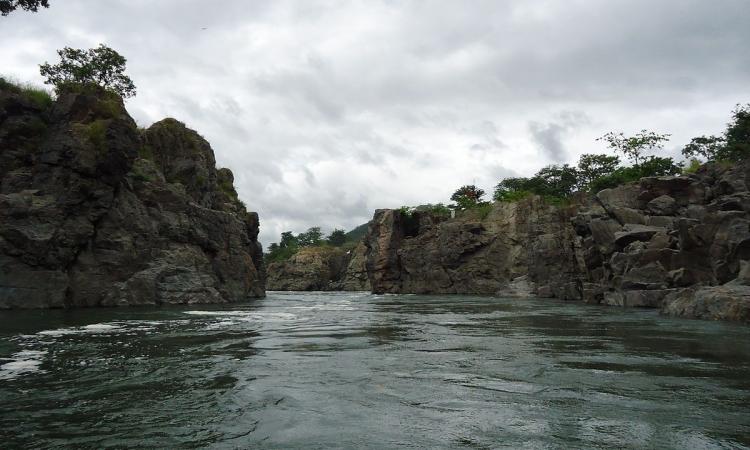
Agricultural intensification in India has increased nitrogen pollution, leading to water quality impairments. The fate of reactive nitrogen applied to the land is largely unknown, however. Long-term records of riverine nitrogen fluxes are nonexistent and drivers of variability remain unexamined, limiting the development of nitrogen management strategies.
India could be facing a water quality crisis as climate change affects the monsoon season, according to a new study from Carnegie’s Anna Michalak and Eva Sinha published in Environmental Science & Technology.
Rainfall and other precipitation wash nutrients like nitrogen from fertilizers into waterways. Human actions, primarily through fertilizer addition, fossil fuel combustion, and increased cultivation of legumes, have more than doubled the amount of reactive nitrogen in terrestrial ecosystems, thus altering the global nitrogen cycle.
Climate, fertilizer inputs, and water storage capacities vary widely across river basins in India, likely further contributing to spatial and temporal variability in nitrogen fluxes.
When rivers, lakes, and coastal areas get overloaded with this runoff, a dangerous phenomenon called eutrophication can occur, which sometimes leads to toxin-producing algal blooms or low-oxygen dead zones called hypoxia. This over-enrichment of nitrogen and resulting eutrophication have contributed to impacts including harmful algal blooms (HABs) and hypoxia.
For several years, Sinha and Michalak have been studying the effects of nitrogen runoff and the ways that anticipated changes in rainfall patterns due to climate change could lead to severe water quality impairments. In this most-recent paper titled ‘India’s Riverine Nitrogen Runoff Strongly Impacted by Monsoon Variability’ they focused on the impact of agricultural nitrogen runoff from Indian river basins.
Between 1970 and 2015, the rate of fertilizer used by Indian farmers increased tenfold due to improvements in agricultural productivity needed to feed a growing population. However, the fate of the nitrogen from these applications remains largely unknown.
“Around the world, more than a fifth of nitrogen released by human activity ends up in aquatic ecosystems, where it increases the risk of severe water quality impairments,” Sinha explained.
Sinha, Michalak, and Princeton University colleagues Venkatramani Balaji and Laure Resplandy set out to characterize seasonal, annual, and regional fluctuation in the amount of nitrogen dissolved in seven major Indian river basins over a 33-year period ending in 2014.
The study leveraged dissolved inorganic nitrogen (DIN) and discharge data to characterize the seasonal, annual, and regional variability of DIN fluxes and their drivers for seven major river basins from 1981 to 2014.
It finds large seasonal and interannual variability in nitrogen runoff, with 68% to 94% of DIN fluxes occurring in June through October and with the coefficient of variation across years ranging from 44% to 93% for individual basins. This variability is primarily explained by variability in precipitation, with year- and basin-specific annual precipitation explaining 52% of the combined regional and interannual variability.
They revealed that the basins’ nitrogen content varied by season and year, which correlated with changes in precipitation. However, there was little evidence that the increased fertilizer deployed by Indian farmers over the last three decades ended up in these waterways.
“For now, the nitrogen from this agricultural boom has ended up in groundwater or the atmosphere,” Michalak said.
Indian basins with higher average fertilizer application rates (e.g., Krishna and Cauvery basins) actually have lower DIN fluxes relative to basins with lower fertilizer application rate (e.g., Brahmani and Baitarni basin and Subernarekha basin). This discrepancy is caused by the large spatial variability in precipitation, with basins with the highest fertilizer application rates experiencing some of the lowest precipitation rates, and vice versa.
The study finds little correlation with rising fertilizer application rates in five of the seven basins, implying that agricultural intensification has thus far primarily impacted groundwater and atmospheric emissions rather than riverine runoff.
However, as climate change alters global precipitation patterns, and monsoons are expected to get more intense, this excess is increasingly likely to end up polluting these rivers and endangering water quality.
“Management strategies must account for the sensitivity to rainfall variation that our study revealed,” Sinha concluded. “They are a signpost that indicates potential risk for water quality issues as weather patterns become more extreme in a warming world.”
These findings imply that strategies for reducing DIN loading must explicitly consider the role of interannual variability in meteorological conditions. In addition, the strong influence of climatic factors means that water quality management strategies aimed at reducing the occurrence of impairments such as harmful algal blooms and coastal hypoxia must be resilient to climatic variability and change.
Riverine nitrogen runoff in India is highly sensitive to projected future increases in precipitation and intensification of the seasonal monsoon, while the impact of projected continued land use intensification is highly uncertain.
The results suggest that in highly managed river basins in southern India, fertilizer application rates have had only a secondary effect on riverine nitrogen fluxes since the 1980s, although this may change in the future as fertilizer application rates continue to rise.
Historical increases in fertilizer application rates have likely negatively impacted groundwater quality and atmospheric nitrogen emissions more so than riverine fluxes; additional research is needed to substantiate the scale of this impact.
The results also point to the differential impact of fertilizer application on DIN fluxes for various river basins and, therefore, reinforce the need for basin-specific management strategies.
The full paper can be accessed here
This work was supported by the U.S. National Science Foundation, the Cooperative Institute for Climate Science, Princeton University, the National Oceanic and Atmospheric Administration, the U.S. Department of Commerce, and the French Agence Nationale de la Recherche